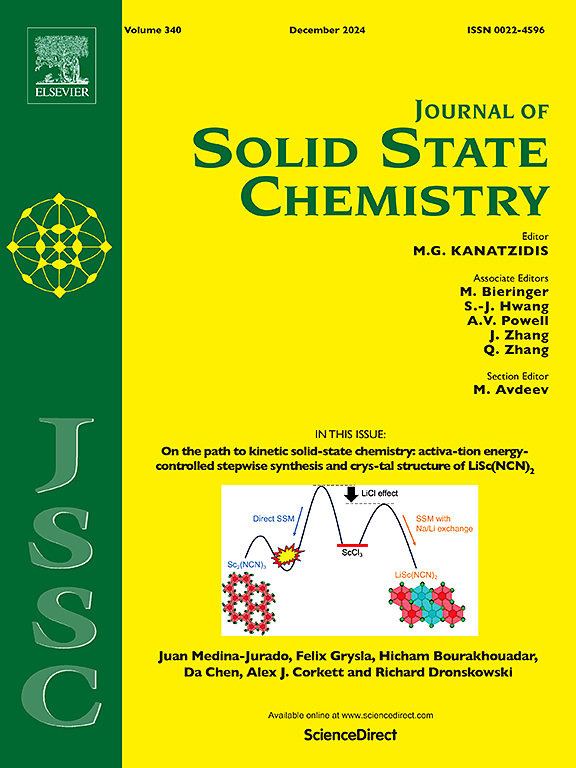两种新型胺传感光致变色配合物
IF 3.5
3区 化学
Q2 CHEMISTRY, INORGANIC & NUCLEAR
引用次数: 0
摘要
具有光致变色和光致发光性质的多功能紫外光基配合物由于其显著的特性一直是人们研究的热点。以1,2,4,5-苯四羧酸(H4BTEC)、ZnSO4·7H2O或3CdSO4·8H2O为基料,以及一种新的紫素配体1,1′-[1,4-苯基双(亚甲基)]-双(4,4′-联吡啶基)二氯化物(pbpy·2Cl)为基础,在溶剂热条件下合成了两个紫素基配合物,分别命名为{[Zn(pbpy)0.5(BTEC)0.75]·2H2O}n(1)和{[Cd3(pbpy)(BTEC)2(H2O)2]·H2O}n(2)。配合物1和2不仅具有可逆的光致变色性质,而且具有光控发光性质。利用时变密度泛函理论(TDDFT)研究了配合物1和2的变色机理。值得注意的是,由于pbpy的缺电子能力,配合物1在暴露于NH3·H2O、苯胺和邻甲苯胺后呈现出明显的视觉颜色变化。同时,配合物2在暴露于氨蒸汽时呈现出明显的颜色变化。配合物1和2对NH3·H2O的低检出限分别为8.52 × 10−6 M−1和15.56 × 10−6 M−1。在配合物1中,双核锌团簇通过配体桥接形成二维蜂窝结构,而在配合物2中,三核镉团簇通过连接形成三维网状结构。配合物1变色速度快,对NH3·H2O的检出限浓度低。本文章由计算机程序翻译,如有差异,请以英文原文为准。

Two novel photochromic complexes based on viologen for amine sensing
Multifunctional viologen-based complexes with photochromic and photoluminescent properties have always been an actively studied subject owing to their remarkable characteristics. Based on 1,2,4,5-benzenetetracarboxylic acid (H4BTEC), ZnSO4·7H2O or 3CdSO4·8H2O, and a novel viologen ligand, 1,1'-[1,4-phenylenebis(methylene)]-bis(4,4′-bipyridyl) dichloride (pbpy·2Cl), we have synthesized two viologen-based complexes, named {[Zn(pbpy)0.5(BTEC)0.75]·2H2O}n (1) and {[Cd3(pbpy)(BTEC)2(H2O)2]·H2O}n (2), under solvothermal conditions. Complexes 1 and 2 not only show reversible photochromic properties, but also possess photo-controlled luminescence properties. The discoloration mechanism of complexes 1 and 2 was investigated via Time-Dependent Density Functional Theory (TDDFT). Notably, because of the electron-deficient capability of pbpy, complex 1 shows significant visual color change after being exposed to NH3·H2O, Aniline and o-Toluidine. At the same time, complex 2 exhibits a distinct color change when exposed to ammonia vapor. Both complexes 1 and 2 exhibited low limits of detection (LOD) for NH3·H2O, 8.52 × 10−6 M−1 and 15.56 × 10−6 M−1, respectively. The binuclear zinc clusters are bridged through ligands to construct a 2D honeycomb structure in complex 1, while the trinuclear cadmium clusters are connected to form a 3D network structure in complex 2. Complex 1 has a faster discoloration rate and a lower detection limit concentration for NH3·H2O.
求助全文
通过发布文献求助,成功后即可免费获取论文全文。
去求助
来源期刊

Journal of Solid State Chemistry
化学-无机化学与核化学
CiteScore
6.00
自引率
9.10%
发文量
848
审稿时长
25 days
期刊介绍:
Covering major developments in the field of solid state chemistry and related areas such as ceramics and amorphous materials, the Journal of Solid State Chemistry features studies of chemical, structural, thermodynamic, electronic, magnetic, and optical properties and processes in solids.
 求助内容:
求助内容: 应助结果提醒方式:
应助结果提醒方式:


